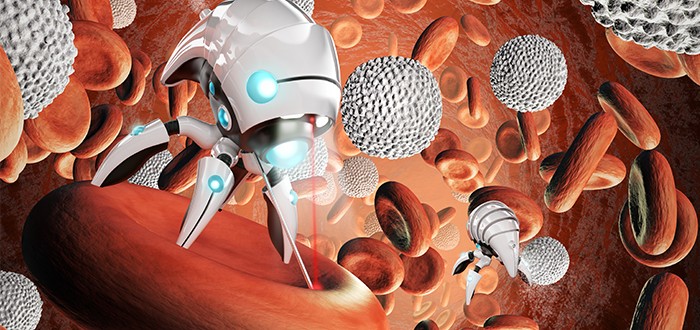Mesothelioma chemotherapy can be unpleasant. Maybe unpleasant isn’t the right word. Brutal might be better.
Of course, whether mesothelioma chemotherapy is unpleasant or brutal depends a lot on your condition at the time you undergo it.
If you’re in decent shape, mesothelioma chemotherapy might not be too bad. Otherwise, you’d best batten down the hatches and rig for rough sailing. But there might be a solution on the horizon.
Researchers know that mesothelioma chemotherapy is tough medicine for many to swallow. So they’ve been working hard at figuring out ways to minimize its ill effects.
One approach is the DNA nanobot. A nanobot is a device that operates at the molecular level. A red blood cell is 200 times larger than a nanobot, that’s how small these things are.
Nanobots function in ways similar to the microRNA nanocells we’ve already reported on. But nanobots are more complex devices than nanocells.
The concept behind them is the same, however. When you’re given mesothelioma chemotherapy the old-fashioned way, the drugs disperse everywhere inside you. As a result, you get side effects.
With nanobots, the mesothelioma chemotherapy drugs do not disperse throughout your body. The drugs are delivered to the mesothelioma cells — and to the mesothelioma cells only.
Nanobots Not Yet Used Against Mesothelioma
Actually, mesothelioma cells are not yet the targets. Researchers are currently testing nanobots on other cancers. But hopefully it won’t be long before they get around to unleashing them against mesothelioma.
One of the most promising nanobot delivery systems comes from the Wyss Institute at Harvard University. Their nanobot can be filled with a molecule-sized dose of whatever chemo drug they want.
Harvard’s nanobot is shaped like a barrel. But unlike a barrel, its contents aren’t gradually poured out through an uncorked hole. The nanobot splits open and dispenses all at once what’s inside.
Its clamshell-like halves stay closed and locked tight until they encounter a cancer cell. The key that opens the barrel is the cancer cell itself.
More precisely, the key is a very specific protein molecule the cancer cell expresses from its outer surface. No healthy cell produces this protein, so no healthy cell has the key to open the lock.
Even more precisely, there are two locks keeping the barrel halves closed. Both locks are made from DNA double helices.
The drug molecule is released when the nanobot finds a cancer cell. The drug is then immediately taken up by the cancer cell. No nearby healthy cell is affected.
Nanobots Are Loaded with Chemo Drugs
Harvard scientists produce their nanobots with the help of a technique known as DNA origami. DNA origami is a process that allows precise construction of hyper-small things.
The process involves mixing long, single-strand DNA together with short-strand DNA. The short-strand DNA is engineered in such a way so that the two types will self-assemble into a predetermined shape.
Once the nanobot finishes building itself, the scientists can then load in the chemotherapy drug. They do this by adding nanobots and drugs into the same beaker or lab dish.
The chemotherapy drug then automatically rushes in to fill the interior of the nanobot. The secret to that is they add a linker molecule to the chemotherapy drug.
The linker has an affinity for not just the drug but also the interior of the nanobot. Think of two metal objects with a powerful magnet in the middle.
Much more testing is in store for nanobots and the delivery of side-effects-free chemotherapy for cancer patients, including those who have mesothelioma. But it’s clearly a therapy approach that holds real promise for the future.


